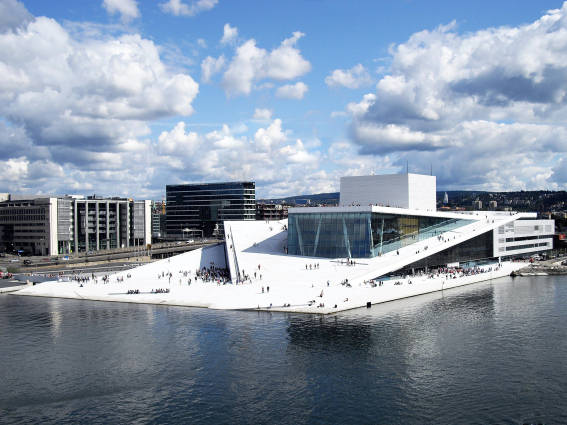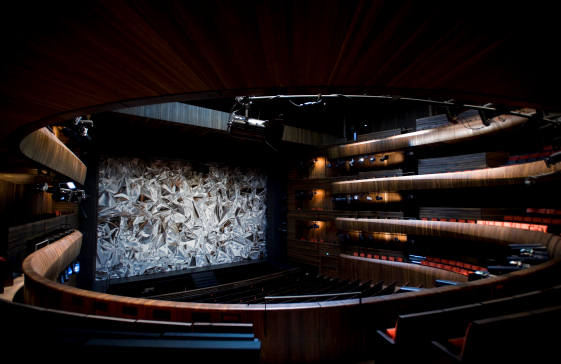Other Links
Editorial Board
- Editor - Bill Kenny
- Deputy Editor - Bob Briggs
- Founder - Len Mullenger
Google Site Search
SEEN AND HEARD ARTICLE
The New Opera House in Oslo: Göran Forsling takes a guided tour (GF)

The Opera House from the air -
Picture
courtesy of Operaen
Oslo
Like a snow-covered mountain top the new opera house rises in Oslo’s former port Björvika, a few hundred meters from the Central Station. The name of the architects’ firm behind this creation is Snøhetta, which literally means snow-cap. On my recent visit to Oslo to see Dvorak’s Rusalka (see review), my wife and I were invited to a private showing of the facilities. Our charming guide Berit Aarøe pointed out from the outset the philosophy behind the construction. Located just off the mainland it functions as a link between the country and the rest of the world. The Oslo Fjord is the Norwegian capital’s connecting link with the North Sea and Norway has always been a country of seafarers. In fact there are obvious references to ships in the design of the public spaces inside the opera house.
The shining white pyramid-shaped building – made of Italian marble – is the most monumental building made in Norway since the Nidaros (today Trondheim) Cathedral was erected in the 12th century. It is intended to be the Norwegian people’s house, a public room and at the same time a landscape. When we arrived on a sunny afternoon lots of people were walking, biking, sitting, lying and playing all over the Kirsten Flagstad Plass (the open area in front of the entrance, where a natural size statue of the famous soprano watches the visitors) but also on the sloping roof and even at the water-edge. It is also possible to walk round the outside of the building and through the large windows in the production department one can look into the workshops or see the ballet dancers rehearsing. In other words the people are invited to follow the everyday work in the house, not just go to the finished performance.
The contact with the public also shows in the various activities – spontaneous or planned – that take place in and on the house. A short while ago, Berit tells us, there were 130 wind-players on the roof! Guided tours, about ten per day, and spoken introductions to every performance are further evidence of the house’s versatility, where there are also facilities for conferences. Sometimes the audience is even invited to take part in a performance – in costumes, singing in the chorus or dancing in the ballet. A kind of workshop.
Outside everything is in stone: then the connection between outside and inside is glass and inside everything is in wood, arranged like the annual rings in a tree. The lightest colours are first and then they become gradually darker and the central part – in this case the main auditorium – is dark brown. What is also interesting, and contributes to a sense of movement and flexibility, is that there are principally no vertical and horizontal lines anywhere. Everything is more or less askew, creating a sense of movement, like a ship gently rocking on the waves.
About 6000 workers from many different countries have been involved during the building period, people of various categories. Even a group of learning disabled people has found meaningful tasks – further evidence that this is indeed a house for the people made by the people; it’s possibly the most democratic opera house in the world.
Before the project started the architects and people from the management went round to other new or recent houses to learn from their mistakes, so that everything would be optimal from the beginning. In the main hall there were three criteria to be fulfilled: excellent acoustics, good sight from every seat and closeness to the stage. Central to the acoustics is the gigantic chandelier, seven meters in diameter, weighing eight tons and consisting of 5800 handmade crystals, ingenuously designed so they reflect the sound with the same clarity irrespective of where one is seated in the hall. There are acoustical curtains on the balconies and the orange-coloured seats are also designed so that the acoustics are the same when there is an audience there and when the hall is empty. That way conductor and orchestra know what the final sound will be like also during rehearsals. The reverberation time is an ideal 1.7 seconds, and the hall is also used for concerts, when the pit floor is raised up to stage level. Those orange seats, by the way, create a warm and joyful atmosphere in the otherwise dark setting of the hall.

The Front Curtain - Picture © Erik Berg
The outer curtain, designed by an American artist, is made to look like wrinkled aluminium foil. Very special, indeed. The first reaction may be a kind of alienation, but since the whole opera house is very special, the curtain is only a further building-block in the concept. Every seat has its own monitor for the subtitles and there is a choice between Norwegian and English.
Every single activity at the Norwegian Opera is performed within the building complex and on our promenade through the house we passed through rehearsal rooms for the ballet, giving the final touches for the approaching premiere of Giselle, and the large workshop where the sets are being produced. The material for the floor in the ballet rooms was chosen by the dancers themselves, Berit tells us, and this is only one example of the democratic process. During the whole building period a number of user-groups were in regular contact with the architects and the building company, to guarantee that the various needs of all categories of users will be satisfied.
Behind the opera house there are cranes and barracks and in front of the house heavy traffic on a through route, but all this will be changed in due time. The traffic is to be conveyed through tunnels and around the opera house residential blocks, a museum and a library are to be built, making the area a cultural centre.
Through a large window we catch a glimpse of a bus, belonging to NRK, the Norwegian radio and television company, and Berit says that they are making a film about the opera house to be shown at the world exhibition in Shanghai 2010. This will be great publicity. The performance of Rusalka was also filmed the next day.
We visit the main stage, which is 16 x 16 meters, divided in four independent blocks that are vertically adjustable. The technical resources are practically limitless but it took some time to get everything work properly and during the first year they had to change programmes several times. But today everything is in order and the Oslo opera is probably the most advanced opera house in the world.
For the inauguration of the house the opera director invited every urban and rural district in the country to send one representative to form a gigantic chorus, singing Va, pensiero, the chorus of the Hebrew slaves from Verdi’s Nabucco. Those 450 amateurs marched in to honour all the ‘slaves’ who had worked on the house. Another marvellous manifestation that this is the Norwegian people’s opera.
Besides the main stage there are two smaller stages for more experimental works with more flexible furnishing. These stages seat 400 and 200 onlookers respectively while the main auditorium seats 1,364.
A few other facts: the gross area is 38,500 m² with 1,100 rooms; public areas 11,200 m²; stage areas 8,300 m²; rehearsal rooms, administration and workshops 19,100 m².
The Norwegian parliament, Stortinget, took the decision to build a new opera house in 1999. Up till then the National Opera had played in an old theatre and cinema with limited resources, since 1959, when Kirsten Flagstad became the first Opera Director. But during the first years of the new millennium things happened in rapid succession: the building work started in 2003 and in September 2007 certain activities moved in, some workshops for instance. On 12 April 2008 the house opened officially with a gala evening that was televised. During the first year 1.3 million people had visited the house. Indeed an opera house for the people! First-time visitors approaching the opera house from the central station, just 300 m away, can follow the development of the building project in photographs on the sides of the footbridge that leads people safely above the street - from the empty bay in June 1999 until the inauguration in 2008. ‘The new opera house in Oslo is a must see’, I read somewhere. I wholly
agree.
Göran Forsling
Back to Top
Cumulative Index Page
